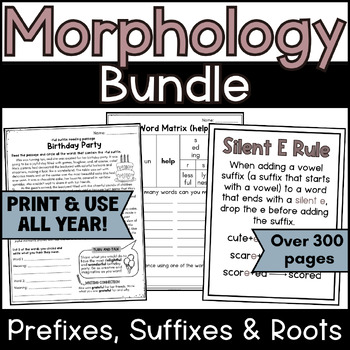Morphology BUNDLE | Word Sum Notebook | Word Wall | Reading Passages | Matrixes
Read Teach Repeat AB
70 Followers
Grade Levels
1st - 6th, Homeschool
Subjects
Resource Type
Standards
CCSSL.1.4b
CCSSL.1.4c
CCSSL.2.4b
CCSSL.2.4c
CCSSL.3.2e
Formats Included
- Zip
Pages
300+
Read Teach Repeat AB
70 Followers
What educators are saying
This is a very comprehensive resource that is perfectly aligned with the morphology lessons I have been implementing in my classroom.
Products in this Bundle (6)
showing 1-5 of 6 products
Bonus
All Resources Together in One Document
Description
This Morphology BUNDLE features 4 of Read Teach Repeat's Morphology Packs to teach and support morphological learning in your classroom all year long!
Featuring:
1. Morphology Word Sum Notebook
2. Morphology Word Wall (NOW in 3 different colour palette options!)
3. Morphology Activities
4. Latin & Greek Roots Word Wall and Activities
All Prefixes and Suffixes included in the Word Sum Notebook and Word Wall for:
- Alberta Curriculum Grades 1 - 6
- Ontario Curriculum Grades 1 - 4
- Saskatchewan Curriculum Grades 2 - 4
For Savings, Freebies & TPT credits:
- Follow us on TPT to be notified of new products & freebies. New products are 20% off for the first 48 hours!
- Provide feedback on purchased products to receive TPT credits toward future purchases
Total Pages
300+
Answer Key
N/A
Teaching Duration
1 Year
Report this resource to TPT
Reported resources will be reviewed by our team. Report this resource to let us know if this resource violates TPT’s content guidelines.
Standards
to see state-specific standards (only available in the US).
CCSSL.1.4b
Use frequently occurring affixes as a clue to the meaning of a word.
CCSSL.1.4c
Identify frequently occurring root words (e.g., look) and their inflectional forms (e.g., looks, looked, looking).
CCSSL.2.4b
Determine the meaning of the new word formed when a known prefix is added to a known word (e.g., happy/unhappy, tell/retell).
CCSSL.2.4c
Use a known root word as a clue to the meaning of an unknown word with the same root (e.g., addition, additional).
CCSSL.3.2e
Use conventional spelling for high-frequency and other studied words and for adding suffixes to base words (e.g., sitting, smiled, cries, happiness).





